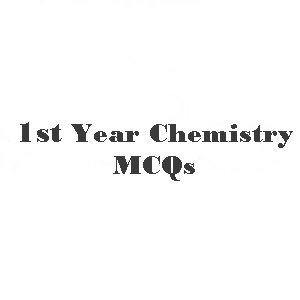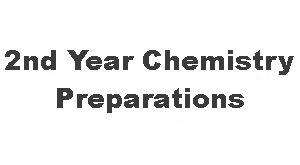This is the place where you will get 1st Year Chemistry Solutions MCQs with Answers. A solution is made by mixing two or more different types of substances. Solutions have different types of concentration Units. These units include Molality, Mole fractions, and Molarity. Solutions have types that differ from the mixing of types of Matter. Raoult’s law has much interference in Solutions. The percentage or amount of solute added in solution is termed as Solubility. Solutions have their different Colligative Properties. Hydration and Hydrolysis tell us about the interactions of different ions, salts, and other particles of Solution. So, this is the brief introduction of this chapter. Scroll down to get the important MCQs of this chapter.
1st Year Chemistry Solutions MCQs with Answers

KEY POINTS
- Concentration Units of Solution
- Types of Solution
- Raoult’s Law
- Vapour Pressure of Liquid-Liquid Solutions
- Solubility and Solubility Curves
- Colligative Properties of Solutions
- Energetic of Solution
- Hydration and Hydrolysis
Question#1. 10g NaOH is dissolved in 1000g water. The molality of NaOH is:
- 1m
- 0.5m
- 4m
- 0.25m
Answer
Answer
Question#2. 250cm3 of 0.2 molar potassium sulphate solution is mixed with 250cm3 of 0.2 molar KCl solution. The molar concentration of K+ ions is:
- 0.2 molar
- 0.3 molar
- 0.25 molar
- 0.35 molar
Answer
Answer
Question#3. The molality of pure water is:
- 1
- 55.5
- 18
- 6
Answer
Answer
Question#4. Molal boiling point constant is the ratio of the elevation in the boiling to:
- Molarity
- Mole fraction of solvent
- Molality
- Mole fraction of the solute
Answer
Answer
Question#5. The number of molecules of sugar in 1dm3 of 1M sugar solution is:
- 6.02 x 1023
- 3.42 x 6.02 x 1022
- 6.02 x 1020
- None of the above
Answer
Answer
Question#6. Colligative properties can be used for calculating:
- The density of a compound
- The lattice energy of a compound
- The molecular mass of a compound
- All of the above
Answer
Answer
Question#7. 18g glucose is dissolved in 90g water. The relative lowering of vapor pressure is equal to:
- 1/5
- 1/51
- 5.1
- 1/55.5
Answer
Answer
Question#8. A solution has 92g ethanol, 96g methanol, and 90g water. Mole fraction of water in the solution is:
- 0.1
- 0.4
- 0.2
- 0.5
Answer
Answer
Question#9. Elevation of boiling point can be best studied by:
- Beckmann’s method
- Landsberger’s method
- Gibb’s method
- None of the above
Answer
Answer
Question#10. For observing Colligative properties, which of the following conditions should be fulfilled?
- The solution should be dilute
- Solute should be non-electrolyte
- Solute should be non-volatile
- All of the above
Answer
Answer
Question#11. When the solvent is containing non-volatile solute particles, then:
- Vapor pressure is decreased
- Vapor pressure doesn’t change
- Vapor pressure is elevated
- Volume is decrease
Answer
Answer
Question#12. The freezing point is the temperature of the substance at which its solid and liquid phases have the:
- Different vapor pressure
- Same volume
- Same vapor pressure
- Same density
Answer
Answer
Qv13. A solution of glucose is 10%. The volume in which 1g mole of it will be dissolved is:
- 1 dm3
- 200 dm3
- 1.8 dm3
- 180 dm3
Answer
Answer
Question#14. Which of the following is not a colligative property?
- Density
- Elevation of boiling point
- Depression in freezing point
- Osmotic pressure
Answer
Answer
Question#15. The substances which don’t dissolve in a reasonable amount in a particular solvent are_____.
- Miscible
- Well soluble
- Sparingly soluble
- Insoluble
Answer
Answer
Question#16. Which one of the following solution of glucose in water is more dilute?
- 0.1 molar
- 0.1 molal
- 1% w/w
- All have the same concentration
Answer
Answer
Qv17. Which liquid solute is dissolved in the liquid solvent, then the best unit of concentration is?
- % w/w
- % w/v
- % v/v
- % v/w
Answer
Answer
Question#18. Which of the following is an example of solid in solid solution?
- Dust particles in smoke
- Opals
- Mercury metal in silver metal
- All of the above
Answer
Answer
Question#19. A colligative property is not represented by:
- Elevation of boiling point
- Osmotic pressure
- Freezing point
- Relative lowering of vapor pressure
Answer
Answer
Question#20. A solution of KCl in water contains:
- Free formula units
- Free ions
- Free atoms
- Free molecules
Answer
Answer
Question#21. For very dilute solution the following expression is used:
- Gram per million
- Nanogram per million
- Microgram per million
- Parts per million
Answer
Answer
Question#22. That solution which possesses a maximum concentration of solute at a given temperature is known as:
- Unsaturated
- Saturated
- Supersaturated
- Dilute solution
Answer
Answer
Question#23. Which of the following 0.1 m solution will have the lowest freezing point?
- K2SO4
- NaCl
- Glucose
- Urea
Answer
Answer
Question#24. Which has the highest freezing point?
- 1.0 m NaCl
- 1.0 m CaCl2
- 1.0 m Urea
- 1.0 m KCl
Answer
Answer
Question#25. Which of the following statement is true about ideal solutions?
- The change in volume is zero
- The change in enthalpy is zero
- The vapor pressure change is zero
- Both a and b
Answer
Answer
Question#26. The addition of sodium chloride to water, while boiling eggs results to:
- Decrease boiling point of water
- Increase the boiling point of water
- Prevent breaking of eggs
- Make egg tasty
Answer
Answer
Question#27. Which pair of the following will not form an ideal solution?
- C2H5Br + C2H5I
- H2O + C4H9OH
- C6H14 + C7H16
- CCl4 + SiCl4
Answer
Answer
Question#28. The study of elevation of boiling point is called:
- Ebullioscopy
- Cryoscopy
- Osmometer
- None of these
Answer
Answer
Question#29. A solution of glucose is 10% w/v. The volume in which 1g mole of it is dissolved will be:
- 1dm3
- 200 cm3
- 900 cm3
- 1.8 dm3
Answer
Answer
Question#30. The relative lowering of vapor pressure is equal to:
- Mole fraction of solvent
- Mole fraction of solution
- The molar mass of solute
- Mole fraction of solute
 Online Exams Tests Preparation
Online Exams Tests Preparation


